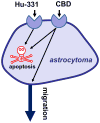Cannabinoid and cannabinoid-like receptors in microglia, astrocytes, and astrocytomas
- PMID: 20468046
- PMCID: PMC2919281
- DOI: 10.1002/glia.20983
Cannabinoid and cannabinoid-like receptors in microglia, astrocytes, and astrocytomas
Abstract
CB1 and CB2 receptors are activated by a plethora of cannabinoid compounds, be they endogenously-produced, plant-derived or synthetic. These receptors are expressed by microglia, astrocytes and astrocytomas, and their activation regulates these cells' differentiation, functions and viability. Recent studies show that glial cells also express cannabinoid-like receptors, and that their activation regulates different cell functions, but also control cell viability. This review summarizes this evidence, and discusses how selective compounds targeting cannabinoid-like receptors constitute promising therapeutics to manage neuroinflammation and eradicate malignant astrocytomas. Importantly, the selective targeting of cannabinoid-like receptors should provide therapeutic relieve without inducing the typical psychotropic effects and possible addictive properties associated with the use of Delta9-tetrahydrocannabinol, the main psychotropic ingredient produced by the plant Cannabis sativa.
Copyright 2010 Wiley-Liss, Inc.
Figures





Similar articles
-
Microglial Cannabinoid CB2 Receptors in Pain Modulation.Int J Mol Sci. 2023 Jan 25;24(3):2348. doi: 10.3390/ijms24032348. Int J Mol Sci. 2023. PMID: 36768668 Free PMC article. Review.
-
The expression level of CB1 and CB2 receptors determines their efficacy at inducing apoptosis in astrocytomas.PLoS One. 2010 Jan 14;5(1):e8702. doi: 10.1371/journal.pone.0008702. PLoS One. 2010. PMID: 20090845 Free PMC article.
-
Receptor-heteromer mediated regulation of endocannabinoid signaling in activated microglia. Role of CB1 and CB2 receptors and relevance for Alzheimer's disease and levodopa-induced dyskinesia.Brain Behav Immun. 2018 Jan;67:139-151. doi: 10.1016/j.bbi.2017.08.015. Epub 2017 Aug 24. Brain Behav Immun. 2018. PMID: 28843453
-
Cannabinoid CB1 and CB2 receptor ligand specificity and the development of CB2-selective agonists.Curr Med Chem. 2008;15(14):1428-43. doi: 10.2174/092986708784567716. Curr Med Chem. 2008. PMID: 18537620 Review.
-
The diverse CB1 and CB2 receptor pharmacology of three plant cannabinoids: delta9-tetrahydrocannabinol, cannabidiol and delta9-tetrahydrocannabivarin.Br J Pharmacol. 2008 Jan;153(2):199-215. doi: 10.1038/sj.bjp.0707442. Epub 2007 Sep 10. Br J Pharmacol. 2008. PMID: 17828291 Free PMC article. Review.
Cited by
-
The endocannabinoid system in normal and pathological brain ageing.Philos Trans R Soc Lond B Biol Sci. 2012 Dec 5;367(1607):3326-41. doi: 10.1098/rstb.2011.0388. Philos Trans R Soc Lond B Biol Sci. 2012. PMID: 23108550 Free PMC article. Review.
-
Neuroscience. Inflammation to rebuild a brain.Science. 2012 Dec 7;338(6112):1303-4. doi: 10.1126/science.1232331. Science. 2012. PMID: 23224546 Free PMC article. No abstract available.
-
Neuroinflammation in the Central Nervous System: Exploring the Evolving Influence of Endocannabinoid System.Biomedicines. 2023 Sep 26;11(10):2642. doi: 10.3390/biomedicines11102642. Biomedicines. 2023. PMID: 37893016 Free PMC article. Review.
-
CB1 and CB2 Receptor Pharmacology.Adv Pharmacol. 2017;80:169-206. doi: 10.1016/bs.apha.2017.03.007. Epub 2017 Jun 12. Adv Pharmacol. 2017. PMID: 28826534 Free PMC article. Review.
-
Mini-review: The therapeutic role of cannabinoids in neuroHIV.Neurosci Lett. 2021 Apr 17;750:135717. doi: 10.1016/j.neulet.2021.135717. Epub 2021 Feb 12. Neurosci Lett. 2021. PMID: 33587986 Free PMC article. Review.
References
-
- Antel J, Becker B. Clinical Neuroimmunology. Montreal: Blackwell Sciences; 1997. Central Nervous System-Immune Interactions: Contribution to neurologic disease and recovery; pp. 26–39.
-
- Baker D, Pryce G, Davies WL, Hiley CR. In silico patent searching reveals a new cannabinoid receptor. Trends Pharmacol Sci. 2006;27(1):1–4. - PubMed
-
- Bari M, Battista N, Fezza F, Finazzi-Agro A, Maccarrone M. Lipid rafts control signaling of type-1 cannabinoid receptors in neuronal cells. Implications for anandamide-induced apoptosis. J Biol Chem. 2005;280(13):12212–20. - PubMed
-
- Becher B, Antel JP. Comparison of phenotypic and functional properties of immediately ex vivo and cultured human adult microglia. Glia. 1996;18:1–10. - PubMed
-
- Begg M, Mo F-M, Offertáler L, Bátkai S, Pacher P, Razdan RK, Lovinger DM, Kunos G. G protein-coupled endothelial receptor for atypical cannabinoid ligands modulates a Ca2+-dependent K+ current. The Journal of Biological Chemistry. 2003a;278(46):46188–46194. - PubMed
Publication types
MeSH terms
Substances
Grants and funding
LinkOut - more resources
Full Text Sources
Other Literature Sources

